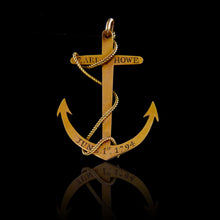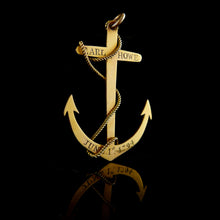Lord Howe Glorious First of June Gilt Anchor Reward Badge, 1794
Adding product to your cart
Overall: 5.2cm (2in) x 4cm (1.5in) x 1mm (0.04in)
Provenance:
Admiral of the Fleet Sir Richard Howe, 1st and last Earl Howe, K.G. (1726-1799),
Lady Sophia Charlotte, who succeeded her father as second Baroness Howe, thence by descent her to her son,
Richard Curzon-Howe, 1st Earl Howe (1796-1870)
George Curzon-Howe, 2nd Earl Howe (1821-1876)
General Richard Curzon-Howe, 3rd Earl Howe, (1822-1900)
Richard George Penn Curzon, 4th Earl Howe (1861-1929)
Francis Penn Curzon, 5th Earl Howe (1884-1964)
Edward Penn Curzon, 6th Earl Howe (1908-1984), thence by descent
Gilt bronze. Naval reward badge in the form of a fouled anchor with coiled rope inscribed across the stock ‘EARL HOWE’ across the stock and JUNE 1st 1794’ on the arm. Commissioned in commemoration of the 1st Earl Howe’s Victory over the French Republic’s Atlantic Fleet under Rear Admiral Villaret-Joyeuse on 1 June 1794
Read more
Prior to the general award of naval medals, anchor badges are known to have been worn in commemoration of important naval victories. In his book ‘British Naval Medals’, Admiral Milford Haven states anchor badges ‘were originally made from captured bronze guns by order of Lord Howe, who distributed them amongst men who had distinguished themselves in the battle’. The present gilt example with direct family provenance back to the victorious admiral of the Battle of the Glorious First of June 1794 is presumed a model for wear by an officer of junior rank. (See p. 219, Milford Haven, Admiral The Marquess of (1919), ‘British Naval Medals, Commemorative Medals, Naval rewards’, John Murray, London).
Admiral of the Fleet Sir Richard Howe, K.G. 1st and last Earl Howe (1726-99), or 'Black Dick' (so called from his swarthy complexion), is one of the great figures of British naval history. The son of 2nd Viscount Howe and Maria Sophia Charlotte von Kielmansegge (daughter of George I's Hanoverian Master of Horse and of the king's mistress, the Countess of Darlington), he went to sea in 1740 and won great distinction during the War of the Austrian Succession, Seven Years War and Jacobite Rebellion. In 1758 he succeeded to the family viscountcy on the death of his brother, Brigadier-General George Augustus, 3rd Viscount, at Ticonderoga. He was advanced to rear-admiral in 1770, vice-admiral 1775, and he played an important role in the War of American Independence both as a naval commander and, because of his sympathy with the colonists, as a peace commissioner; his brother, Sir William Howe (1729-1814), who succeeded as 5th Viscount, was principal military commander in America until 1778.
Black Dick successfully relieved the long beseiged British garrison on Gibraltar in 1782 and was afterwards First Lord of the Admiralty, 1783-88. In August of the latter year he was ennobled as Its Earl Howe. In 1793 he took command of the Channel Fleet and led it at the crowning achievement of his career, the Battle of the Glorious First of June (1794). His twenty-two ships and engaged and defeated twenty-five French ships escorting a vital grain convoy France, then starving due to the turmoil of the revolution. He successfully captured seven French warships, if not the convoy, valued at £201,096 in prize money. To celebrate he commissioned gold and gilt and bronze anchor badges to give to participants of the action.
Although this ended his active career, he remained in nominal command until 1797, in which year he performed one of his most valuable services, intervening in the naval mutinies at spithead and the More. Despite his age he spent three days rowing round the fleet at Spithead to inform the seamen of the king's pardon, and was so well trusted by the sailors that all was settled with equanimity; not without reason was he known as the sailor's friend'. In addition to consummate seamanship and professional skill Collingwood wrote that the Battle of the First of June was conducted with such skill that it was like magic - despite a taciturn and reserved demeanour, Howe had great courage and legendary calmness in times of crisis; once, when informed that his ship was on fire, he merely observed, 'If that be the case, we shall soon know it’!








